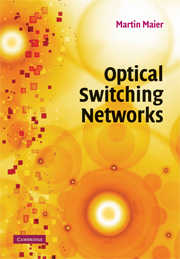Book contents
- Frontmatter
- Contents
- List of illustrations
- List of tables
- Preface
- Acknowledgments
- Part I Introduction
- Part II Optical wide area networks
- Part III Optical metropolitan area networks
- Overview
- 11 Resilient packet ring
- 12 WDM ring networks
- 13 RINGOSTAR
- Part IV Optical access and local area networks
- Part V Testbeds
- Bibliography
- Index
13 - RINGOSTAR
from Part III - Optical metropolitan area networks
Published online by Cambridge University Press: 10 May 2010
- Frontmatter
- Contents
- List of illustrations
- List of tables
- Preface
- Acknowledgments
- Part I Introduction
- Part II Optical wide area networks
- Part III Optical metropolitan area networks
- Overview
- 11 Resilient packet ring
- 12 WDM ring networks
- 13 RINGOSTAR
- Part IV Optical access and local area networks
- Part V Testbeds
- Bibliography
- Index
Summary
The aforementioned wavelength division multiplexing (WDM) ring networks appear to be natural candidates to extend existing optical single-channel ring networks (e.g., RPR) to multichannel systems by means of WDM. In WDM rings, optical single-channel rings are multichannel upgraded by exploiting the already existing fiber infrastructure without requiring any additional fiber links and modifications of the ring topology. Clearly, deploying WDM on the existing ring infrastructure saves on fiber requirements. At the downside, however, WDM rings require all ring nodes to be WDM upgraded at the same time (e.g., each ring node is equipped with a transceiver array or wavelength (de)multiplexer). Furthermore, WDM rings are able to survive only a single link or node failure due to their underlying ring topology, similar to their single-channel counterparts.
An alternative approach to multichannel upgrade optical single-channel rings relies on topological modifications of the basic ring architecture. Many ways exist to modify and enhance the topology of ring networks, resulting in so-called augmented rings (Aiello et al., 2001). In this chapter, we describe a novel multichannel upgrade of optical single-channel ring networks where the ring network is left untouched and only a subset of ring nodes needs to be WDM upgraded and interconnected by a single–hop star WDM subnetwork in a pay-as-you-grow fashion (Maier and Reisslein, 2006). The resultant hybrid ring-star network, called RINGOSTAR, requires additional fiber links to build the star subnetwork, as opposed to WDM rings. Unlike WDM rings, however, RINGOSTAR does not require all ring nodes to be WDM upgraded at the same time.
- Type
- Chapter
- Information
- Optical Switching Networks , pp. 194 - 218Publisher: Cambridge University PressPrint publication year: 2008



